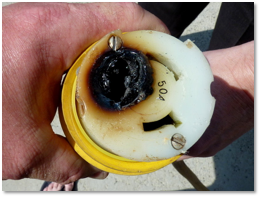I received this email from a writing colleague a few months ago, and was reminded about it during my seminar at the Boston RV show.
Dear Mike,
Many folks have the low cost InfraRed temperature guns for monitoring the temperature of their brakes and wheel hub bearings. I wonder if it might be a good idea to check the temperature of the plug at each connection. I would think that if the connection is clean there should be little or no heat generated so the temperature should be close to the Ambient temperature. Am I correct that we might be able to use an IR gun to check the "quality" of our high amp connections? - Roger Marble
Hey Roger,
You are 100% correct, and that’s a great idea. As I’m sure you’re aware, the twist-lock inlets for shore power on RVs are prone to overheating and meltdown if not properly maintained. And it came as a shock to me when I started asking if everyone at my seminars knew that the plug had to be twisted to “lock” it in and achieve full connection. Some attendees were never shown this by the RV dealer.
Plus the locking ring must be spun on every time, or the weight of the cord can flex the connector body and cause it lose contact. Add some high current usage (like an air conditioner or air fryer) and it’s a recipe for a meltdown.
Be aware that if you see this sort of damage on the female plug of your power cord, that the male inlet receptacle on your RV is also damaged and needs to be replaced.
How to watch for it…
In my FunkWorks Lab I use a pretty expensive FLIR camera to look inside of these plugs for signs of contact overheating. But in actuality, the entire plug assembly will begin to overheat as a first sign of localized contact heating. So I have done a few experiments using an inexpensive InfraRed thermometer to look for early signs of heating.
These thermometers can be purchased at any big-box store or from Amazon for less than $40. I don’t have a particular model to recommend, but I’ll be doing more plug testing in the spring and I’ll see which brand and model works the best. My SWAG (Scientific Wild Ass Guess) is that once the temperature of the plug housing is 20 or 30 degrees above ambient temp it’s a warning that something bad is going to happen.
You’ll want to power down, remove the plug, and look for any signs of overheating. If it looks okay, then a spritz of contact cleaner might solve the problem. But once there’s discoloration or melting of the plastic housing, it’s replacement time.
What causes overheating?
And remember, this overheating can be caused by a few other things other than worn or oxidized contacts in the plug. I’ve also seen some of them fail from loose terminating screws in the plug. And if the campground miswired the 50-amp pedestal with single-pole 120/120-volts on the outlet instead of double-pole 120/240-volts, then the 50-amp neutral conductors and contacts in your shore power cord are guaranteed to be over-current at times up to 100 amps.
If you don’t have an Infrared Thermometer you can still use the hand touch test and just feel the plug for overheating, but these are tests you should do everyday, especially if you’re running a lot of heavy loads. I’ll do a more in-depth article on this soon.
A better plug
I’ve installed a number of SmartPlug connectors on my own RV and colleagues’ trailers, and they’re fantastic. You don’t twist them to lock them in, they’re completely waterproof, and they have 20 times the contact area of a traditional twist-lock plug. They fit into the existing mounting hole on your trailer and the plug end can be installed on your existing shore power cord. I highly recommend them as a replacement for any twist-lock connector, especially if you’ve already had a meltdown. Find out more at SmartPlug.com.
Let’s play safe out there… Mike








Mike,
I use plugs made by Contek. The blades are nickel plated rather than brass and resist heat build up much more effectively. I have not had failures since installing them.
I use the smell test every time I unplug from pedestal or at least once a month during long stays. Unplug and get the plug right to your nose. The distinct hot wire smell never lies, appears before any heat can be detected to the touch, and sticks around for weeks during storage.
I also always have a spare male and female plugs on hand. I find myself replacing at least one male plug per year.